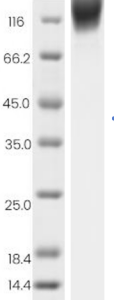Human CD30 Protein, His Tag, Avi Tag
-
产品编号
KMP2273
-
别名
肿瘤坏死因子受体8, Tumor necrosis factor receptor superfamily member 8, CD30
-
规格
- 50ug
- 100ug
- 200ug
| Catalog Number | KMP2273 |
| Alias | 肿瘤坏死因子受体8, Tumor necrosis factor receptor superfamily member 8, CD30 |
| Size | 50ug, 100ug, 200ug |
| Product Description | The Human CD30 Protein(KMP2273) is produced in HEK293 Cells and the target gene encoding Phe19-Lys379 is expressed with a 6His, Avi tag at the C-terminus. |
| Molecular Name | CD30 |
| Product Introduction | CD30:TNF受体超家族成员,通过跨膜形式参与淋巴细胞活化和信号传导。 |
| Molecular Weight | 39.25 kDa |
| Expression System | HEK293 Cells |
| Species | Human |
| Purity | >95% |
| SDS-PAGE |  |
| Purification | Affinity Purification |
| Uniprot ID | P28908 |
| Storage Condition | Aliquot and store at -20℃ to -80℃. Avoid repeated freezing and thawing cycles. |
| Formulation | 20mM PB, 150mM NaCl, pH7.4 |
| Shipping Condition | In general, the proteins are provided as lyophilized powder which are shipped at ambient temperature. They are shipped out in dry ice if supplied in liquid form. |
| Background | CD30, also known as TNFRSF8, is a cell membrane protein of the tumor necrosis factor receptor family, which regulates proliferation/apoptosis and antibody responses. CD30 is expressed by activated, but not by resting, T and B cells. Aberrant expression of CD30 by mastocytosis mast cells and interaction with its ligand CD30L(CD153) appears to play an important role in the pathogenesis and clinical presentation of systemic mastocytosis. CD30 has been considered as a specific diagnostic biomarker of anaplastic large cell lymphoma(ALCL) and classical Hodgkin lymphoma(cHL). CD30 is also a biomarker used for targeted therapy by an antibody–drug conjugate. |
| Endotoxin | <1.0 EU/ug determined by the LAL method |
| Product Declaration | 该产品仅供科研使用,不可直接用于人体或注射。 |
可优化表达条件(如降低诱导温度、调整IPTG浓度)、使用促溶标签(如SUMO、GST)、共表达分子伴侣,或尝试不同宿主系统(如哺乳动物细胞或昆虫细胞)以提高可溶性蛋白产量。
常用的纯化方法包括亲和层析(如His-Tag、GST-Tag)、离子交换层析、疏水相互作用层析(HIC)和凝胶过滤层析。具体方法取决于蛋白特性和标签类型。





 0
0
